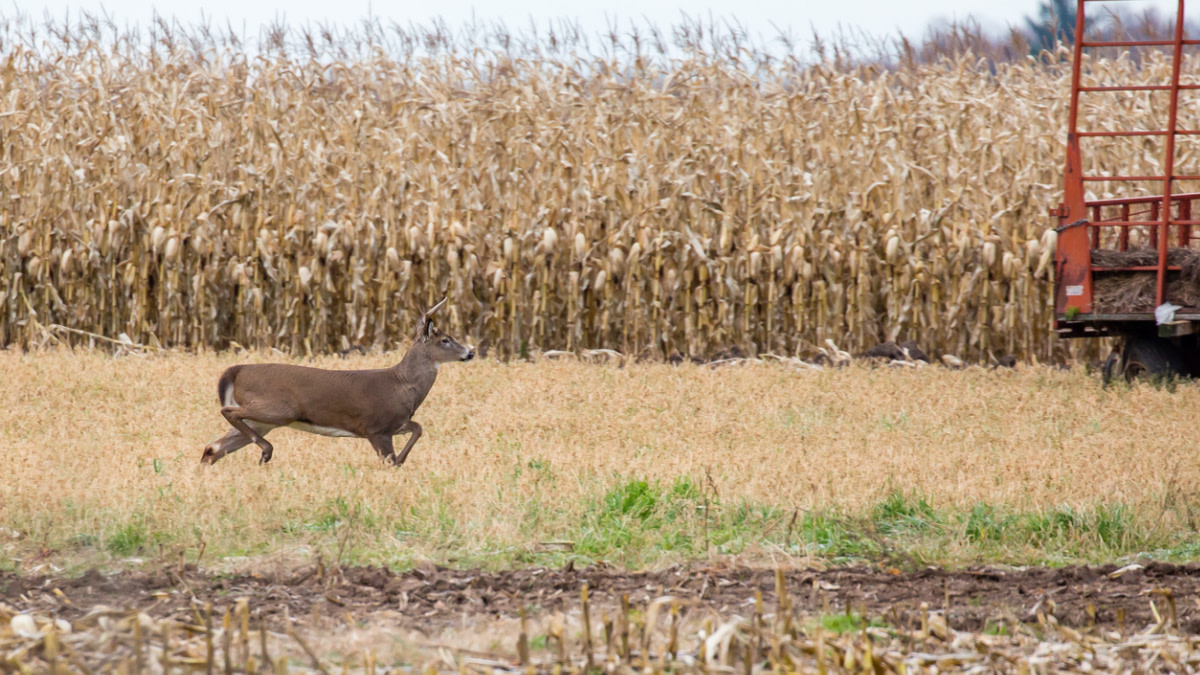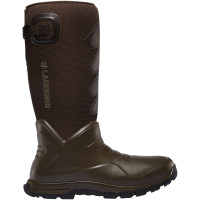
While many hunters value agricultural fields as reliable food sources for deer, one negative aspect of standing cornfields is that mature bucks rarely leave them. Standing corn makes for secure bedding, feeding, and breeding. These reasons give bucks little reason to stray very far. Rather than complain about it, bowhunters should embrace and learn how to hunt standing corn.
Besides dry cattail marshes, very few vegetation types grow tall and dense enough to hide a standing antlered buck completely. Add to the fact that corn doubles as a major food source, and you’ve got the whitetail version of a five-star resort with a Michelin-rated hotel in the lobby.
Unlike situations seen on most TV shows where mature bucks waltz into picked cornfields during daylight, this article is for those who hunt heavily pressured areas. These are places where the few mature bucks that exist will avoid harvested cornfields during daytime activity because, once a cornfield is harvested, it loses its security status for daytime mature buck activity.
I have three proven methods of hunting standing corn. You can use these practices without harming your traditional rut phase locations beyond the field’s edge.
Stalking I’ve taken many deer and a few bucks while stalking corn; even arrowing three does in one day for the freezer. As a bonus, deer shot while stalking usually die in the field, which means you don’t have to leave an invasive human footprint beyond the field, which could disturb your rut phase hunts after the corn harvest.
Weather conditions, timing, and scent control are all fundamental factors for successfully stalking corn.
Twenty-mile-per-hour winds, a steady rain, or a combination of the two are required weather conditions to mask your stalking noise. On a calm day in a dry cornfield, your odds of being successful are around zero due to the aggressive crunching and swishing sounds every step will make.
Most deer will be bedded down during midday, so this is the most opportune time for you to stalk. Deer will be up and active during the mornings and evenings, making it difficult to move in for the kill.
On average, half of the deer will be downwind from you, so quality gear and rubber boots are the best way to keep you from getting winded. In addition, a light beige exterior garment that blends with the corn is critical camouflage—it should be washed in non-scent detergent and worn with a headcover and facemask.
Since you’ll be moving around constantly, dress on the light side so you don’t overheat. Once you think you are dressed right for the temperature, take off one layer. This will save you from having to remove and carry clothing.
Start about 50 yards up either side of the field and stalk perpendicular to the rows. Slowly poke your head into each row and look in both directions for bedded deer. Scan for deer bedded in front of you before stepping into the next row.
To step through standing corn, plant your boot against the root of a stalk, push the stalk sideways with your knee, and step through the gap. Continue this process until you’ve walked through the field, then move down the edge and stalk back through in the opposite direction.
How far you move down the field is dictated by how far down the rows you can see. For example, if you can see 30 yards in each direction, you would move 60 yards down the field before entering for the next pass. Continue this until you cover the entire field.
Deer are likely bedded somewhere in whatever field you choose to stalk, and any fawns or does you spot will probably have company bedded nearby. If you see a deer you want to shoot and you need to get closer, step back five rows, and slowly sneak down the row in the direction of the deer. Once you reach an estimated comfortable shooting distance, nock an arrow and slowly stalk back through the rows until you are one row from the deer. Slowly peek into that row and wait for its attention to stray elsewhere before leaning into the row for the shot.
If you don’t want to shoot, count your steps as you sneak back down the row away from the deer, cross the row, count your steps back to your original position, and return to your stalk.
Stalking corn requires patience. Don’t move too quickly through the field just because of a lack of sightings. Deer can and will be spooked if you go too fast, no matter how loud or distracting the weather conditions are.
Ground Blind Look for the most used runways. Then, go back and follow the most promising runways into the cornfield while searching for other interior runways that converge with it. Or walk the interior of the field in search of the rows with the most traffic.
You’ll find wider rows will receive more traffic because they’re easier to move down. If there’s a rotary watering system, the tire tracks will be major transition runways. Deer will also transition along inside edges where it was too wet to plant or for the corn to grow. While rare, if there’s a waterhole within the field, that would be an excellent location to find deer.
Some fields have untillable swales and their edges receive traffic. If there’s a suitable tree, hunt from it. A weed-lined drainage ditch offers another excellent opportunity for a ground blind as deer will travel along with them.
My preference for a ground blind is to use cut or bent-over cornstalks to make it look as natural as possible and should be no more than 10 yards from the kill area. While large and invasive, pop-up blinds brushed in with cornstalks can also work.
Make two shooting lanes in a ‘V’ fashion with your blind placed at the bottom of the V. This offers a visual and a shooting lane with time to prepare for the shot while deer transition down the row between them. Cut the cornstalks in each lane 20 inches from the ground (just below a deer’s chest level) and when hunting, wear a light beige exterior garment that blends well with the corn.
All inner field locations are best hunted during mornings and evenings but can be effective at any time of day, especially during the rut phases. It’s important to be as quiet as possible during entries and exits as deer can bed down anywhere, and weather conditions are not a factor when ground blind hunting within a cornfield.
Perimeter edge This method requires you to walk its perimeter and set up on the best transition or perimeter signposts in the form of rubs or active scrapes. When in the secure confines of a standing cornfield, mature bucks will cruise their edges scent-checking for does that came in or left the corn.
Along perimeters, bucks will also respond to sparring and rattling sequences. You must have a shooting lane into the corn as they may stop several rows in without exiting the field to search beyond the corn for the amorous bucks.
Hunting standing corn is extremely effective and non-invasive to other locations beyond it, which helps keep your options open once the corn is harvested.






